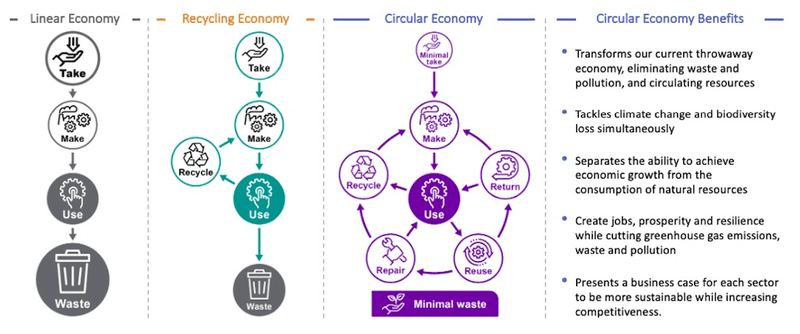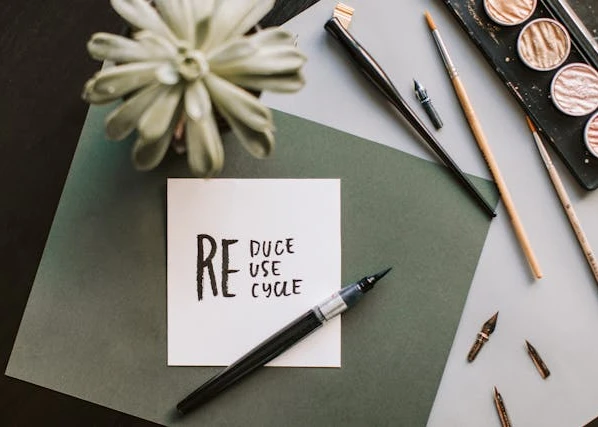Circular Economy: What It Means For Businesses & Consumers
Mar 6, 2024
Shifting from a linear to a circular economic model can be as profitable as it is sustainable. Discover the circular economy and its numerous benefits.
The linear economy is proving to be unsustainable. Research indicates that if we persist with the current take-make-consume-and-discard approach to resource utilisation, we will need 2.3 planets' worth of resources to support our industries by 2050.
As the Earth's resources remain finite and the global population explodes, the strain on already depleted resources intensifies. However, there is a solution to alleviate this pressure: transitioning from a linear to a circular economy.
A circular economy aims to minimise waste by promoting practices such as sharing, leasing, refurbishing, repairing, reusing, and recycling products. This approach not only conserves resources but also safeguards the environment while generating additional value.
Circularity is more than just a buzzword; it presents significant opportunities for businesses that adopt its principles. This article delves into the concept of the circular economy, the opportunities it offers, and its sustainability benefits.
What is the circular economy?

The circular economy is a model of production and consumption that promotes the sustainable use of natural resources through reuse and regeneration. It is the opposite of the linear economy in which people buy products to use and subsequently dispose.
The traditional linear approach to business is inherently wasteful ,leading to vast amounts of waste generation, often in the gigatonnes. Because products are not designed for repairability or recyclability, they are guaranteed to end up in a landfill or discarded somewhere in the natural environment.
What a circular economy means for businesses.
The push for more sustainable business processes has largely failed, underscoring the pressing need for businesses to intensify their efforts in reducing carbon emissions and safeguarding the natural environment.
However, unless Green Credits and other incentives for voluntary environmental protection can be expressed in profit terms, businesses will continue to take a piecemeal approach to a greener future.
The circular economy is the most pragmatic approach to business-sponsored sustainability because it has credible profit potential. Business models like product-as-a-service use fewer raw materials, extend product lifecycles and open new revenue streams.
Businesses can maximise revenue from existing products by transitioning to a service-based model, enabling them to generate higher profits while minimising production outputs. .
In essence, a circular economy means physical products end up back where they started, which is at the manufacturer, not at a dump site. Once returned, these products are either recycled to create new items or refurbished for reuse by another consumer. This process effectively "closes the loop" of product life cycles.
Not every business can successfully close the circle, and that's OK. Some design products that last longer, while others make products that can be easily remanufactured or disassembled for recycling. What's important is to have the mindset to reuse and reduce waste, which can mean being intentional about the business models we adopt:
Business models of the circular economy.
Soon, consumers and governments will make it unsustainable for businesses to use resources wastefully and ignore their responsibility to protect the environment. Climate change, an effect of carbon emissions by industry, is now an inarguable reality due to irregular weather patterns that are causing droughts and flooding.
Consumers are increasingly adopting a more militant approach to register their disapproval of the wanton and reckless extraction of natural resources. They are equally fed up with the fall in product quality as businesses chase higher profits.
Because of all this, consumers demand higher-quality products designed for ease of repair. Many are now re-evaluating their approach to value and ownership, questioning whether they need to own the products they buy or pay to get the benefits they deliver.
From a consumer perspective, two business models of the circular economy show great promise: the Sharing economy and the Product-as-a-Service (PaaS) business model. These two models can solve many of the problems consumers face around sustainability and product quality.
The Sharing economy maximises value from idle resources.
The sharing economy maximises the use of expensive assets. It puts idle assets to use through shared use. This includes consumer assets like cars and business assets like industrial machines.
Instead of everyone buying and driving their car to work every day, four people can share one car. This can significantly lower carbon emissions and cut down on our use of carbon-based fuels, which reduce air quality and cause global warming.
By sharing industrial assets, businesses can save capital and lower their costs, which translates to higher profits or lower prices for consumers.
The Product-as-a-Service business model has the most promising sustainability benefits.
The product-as-a-service model maximises product usage by directing the consumer's attention away from ownership toward performance or product benefit.
Customers simply pay for the usage of the product or the value it provides, , while the manufacturer retains ownership and assumes full responsibility for repair and maintenance.
The biggest benefit of the product-service system, as it's also known, is that it incentivises manufacturers to make higher-quality, more durable products.
Better-quality products require less maintenance and repair and have a longer use life, which allows the company to generate more revenue.
Let's explore more benefits of the product-service-system and the circular economy in general below:
Benefits of shifting to a circular economic model.
The circular economy promotes consumer sharing and reuse, while encouraging manufacturers to repair, refurbish, and recycle products to extend their life cycles. This prolongs product life cycles, conserves scarce resources, and boosts sustainability.
According to statistics from the World Health Organisation, 53.6 million tonnes of e-waste were produced globally in 2019. Only 17% of that waste was recycled. Essentially, we are mining resources only to turn them into waste that chokes the same natural environment we destroyed to extract them.
A more circular approach to production and consumption that business models like pay-per-use cultivates will have benefits for businesses as well as consumers:
1. Creates new jobs and revenue streams.
It sounds counterintuitive that making fewer products and encouraging reuse will create more jobs and grow revenue., but that is precisely what it will do.
Shifting to Product-as-a-Service and other circular business models will create as many as 8 million new jobs as manufacturers innovate ways to recycle and refurbish old products that would otherwise be thrown away.
Additional employment opportunities arise in repair, maintenance, and training sectors within the circular economy. Currently, these job opportunities are being discarded along with the used products that are treated as waste.
2. Allows businesses to build a continuous revenue stream
Adopting the product-service system allows businesses to establish a consistent revenue stream by leveraging the same products over time. Instead of continuously pumping out new products, manufacturers can charge customers recurring fees to use the same products.
For instance, a heavy equipment manufacturer can only serve a limited number of customers before reaching market saturation. Changing their business model to a product-service-system will open a continuous revenue stream and help the manufacturer build a more sustainable business where they are not constantly chasing leads.
3. Encourages manufacturers to produce higher quality products.
Because manufacturers retain ownership and are responsible for maintaining and repairing their products, they have an incentive to produce better-quality, durable products. This also benefits customers by minimising downtime caused by equipment failures.
The product-service model transfers the risk of performance from the customer to the product manufacturer. If the equipment fails, the customer notifies the manufacturer, who has both the responsibility and incentive to repair it promptly. The customer will not pay if they are not using the equipment.
4. Refocuses manufacturers on delivering value to customers.
Physical equipment manufacturers often become overly fixed on aesthetics and fleeting features, sometimes neglecting the product's fundamental function and usability in the process. . Despite looking visually appealing and boasting numerous features, these products may ultimately fail to fulfill their primary functions.
An example is a fridge with easy access, door-in-door storage, smudge-proof finishes, smart home connectivity, water dispensers, and other advanced features but lacks sufficient cooling, leaks water, and does not defrost properly, which are the benefits a customer would pay for under a product-as-a-service subscription.
5. Promotes sustainability.
Under the linear economy, equipment manufacturers mass-produce products as the most viable way of growing revenue. This leads to the excessive extraction of increasingly scarce natural raw materials and increases carbon emissions. It also encourages the production of poor-quality products as companies chase more profits.
The best application of the product-service system simultaneously fulfils customers' needs and minimises waste and reduces the amount of raw materials and energy used. This is a more sustainable approach as the extraction of metals and fossil fuels used for raw materials and energy puts a massive toll on the environment leading to: :
soil erosion,
pollution,
loss of habitat for endangered animal species,
human/wildlife conflict,
Loss of biodiversity,
Unpredictable weather patterns due to climate change.
The product-as-a-service extends the lifespan of products as companies seek to maximise their profits. In a product-centric linear economic model, companies focus on producing more products to boost profits, resulting in excessive extraction of natural resources.
PaaS is a more efficient and ecologically friendly use of natural resources. The products that are currently thrown away, polluting our air and water sources, are repaired and refurbished for reuse.
6. Fosters a closer relationship with customers.
The product-service system forces manufacturers to work more closely with customers to identify ways to improve product reliability, minimise breakdowns, and boost their bottom lines.
Manufacturers can also use customer feedback to innovate new features that enhance product value and eliminate competition. Customers who are happy with the value they are getting maintain their subscriptions for longer.
Where does your business fit in the circular economy?
Some products fit the circular economy better than others. Indeed, only select manufacturers can ''close the circle''. That said, every business can play a role and has ways to benefit.
Are you considering shifting to a pay-per-use, product-as-a-service, or subscription business model, all of which have circular economy credentials? Intasend has the technology to streamline your processes.
Using Intasend's automatic billing and subscription management software, you can take the pain out of collecting customer payments on your website, creating subscription plans, dunning management, and other payment collection processes.
Book a demo to explore the many ways Intasend can help you streamline collections, payments, and disbursements in your business.

